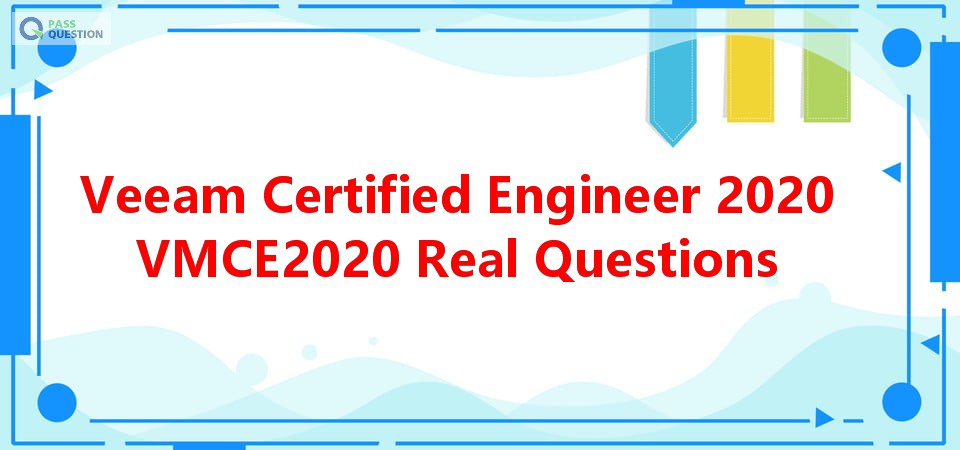Veeam Certified Engineer 2020 VMCE2020 Real Questions
If you are worried about how to become a Veeam Certified Engineer (VMCE),you can take VMCE2020 exam to get certified. PassQuestion will provide you with exam information and Veeam Certified Engineer 2020 VMCE2020 Real Questions to let you be fully prepared to ensure 100% to pass Veeam certification VMCE2020 exam in your first time.PassQuestion Veeam Certified Engineer 2020 VMCE2020 Real Questions include all the knowledge that must be mastered for the purpose of passing the Veeam Certified Engineer exam.

Exam Purpose
The VMCE certification is documented proof that an administrator or engineer has the necessary level of expertise to protect an organization’s data with Veeam Availability Suite™. Holders of Veeam certifications have a deep understanding of Veeam Availability Suite, the critical functions required by an organization to actively protect their data and the ability to grow and adapt with an organization’s evolving data protection needs.
VMCE2020 Exam Information
Number of items: The exam consists of 50 multiple choice and multiple response items.
Passing score: The passing score for the VMCE exam is 70%. Once you pass the exam, you will receive your VMCE certificate,
digital badge and priority access to technical support.
Languages: The exam is available in English (US).
Time limit: Examinees will get 60 minutes to take the exam. A 30-minute time extension will be available when
the exam is delivered in a language different than the local language.
Delivery: The VMCE 2020 exam is delivered through Pearson VUE test centers
VMCE2020 Exam Outline
1: Key concepts of a successful backup strategy (2%)
- Understand Recovery Time Objective (RTO) and Recovery Point Objective (RPO)
2: Building backup capabilities (38%)
- Understand backup use-cases
- Apply appropriate global settings for your environment
- Differentiate between and select the most appropriate backup method
- Understand the backup optimizations that can be applied and their impact
- Understand the concepts behind backup copy jobs
3: Building replication capabilities (10%)
- Understand replication use-cases
- Correctly use the configuration options available within replication
4: 3-2-1 strategy (4%)
- Apply the 3-2-1 rule
5: Testing backup and replication (18%)
- Determine which data lab to use and configure
- Determine and configure an application group
- Combine data labs and application groups into SureBackup jobs
- Set up a sandbox environment
6: Restoring from backup (10%)
- Execute a restore responding to a number of recovery scenarios
7: Recovery from replica (8%)
- Execute a failover responding to a number of recovery scenarios
8: Monitoring and reporting (10%)
- Understand the infrastructure of Veeam ONE
- Configure Veeam ONE
- Set up reports and dashboards
View Online Veeam Certified Engineer 2020 VMCE2020 Free Questions
1.A customer currently has one backup job that runs every four hours to backup their VMs in a transaction consistent state.
Which job configuration will keep all restore points safe in case the primary site and backups go down while still being able to do a point-in-time recovery of a SQL database from the backups on the second site?
A. Configure a second VM backup job and schedule it to copy every four hours, starting at midnight, to a repository on the second site
B. Configure a backup copy job in mirror mode, to a repository on the second site
C. Configure a backup copy job in pruning mode and schedule it to copy every four hours, starting at midnight, to a repository on the second site
D. Configure a backup copy job in pruning mode and have it copy data every day, starting at midnight, to a repository on the second site
Answer: A
2.A NAS backup job has been configured within Veeam Backup & Replication, and is completing successfully, but restore operations have been failing for the last few days.
What is causing the failure?
A. The backup repository is sealed
B. The server was added by using an IQN alias which is unable to be resolved
C. The credentials added to the share are not allowed read-write access to the share, directories or files
D. The cache repository assigned for this file share is unavailable for restore operations
Answer: C
3.A company needs to recover a domain controller from a backup file they have on premises which was created by the Veeam Agent for Microsoft Windows.
Which of the following would provide the fastest access to the domain controller?
A. Use the Veeam Explorer for Active Directory to recover the domain controller
B. Perform an Instant VM Recovery to recover the domain controller to a VM on their VMware host
C. Perform a bare metal recovery of their domain controller back to the original system
D. Recover the domain controller to an AWS EC2 instance using the restore to Amazon EC2
Answer: B
4.What is the main purpose of the planned failover feature?
A. Test the VM in a sandbox without impacting the production environment
B. Proactively switch from running the regular VM to the replica VM
C. Initiate a disaster recovery procedure when the main site is down
D. Test a disaster recovery scenario without any downtime on the VM
Answer: B
5.When you back up regular or standalone VMs in vCloud Director, which of the following is captured and stored in Veeam’s Backup & Replication backup file? (Choose three.)
A. vApp metadata
B. VM disk content
C. Raw device mapping
D. In-guest iSCSI disk
E. VM metadata
F. Linked clone VM’s prior to vCenter 6.5
Answer: ABE
Comments
Post a Comment